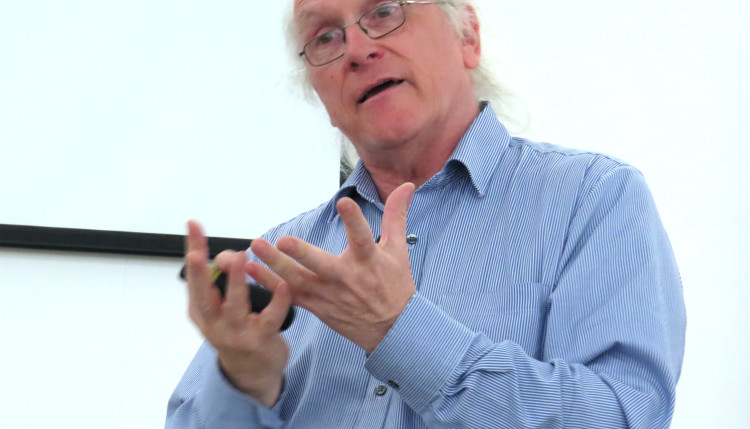
«Cities are people, not buildings»
Visiting Buenos Aires, British Professor Nick Tyler spoke with La Razón newspaper and called to rethink the way we design major world cities from two main objectives: improving the quality of life of people and reduce carbon emissions.
«Why do the cities exist?» Was the question that Nick Tyler addressed the audience. Silence filled the room university and its response was followed by even more quietly: «Because there are people». Professor of Civil Engineering at the University College London (UCL) visited Argentina for the fourth time during the «Climate Month» driven by the European Union delegation in the country. His talk, «The cities of the future in the context of climate change: the experiences of the UK» at the University Torcuato Di Tella, provided an overview of the problems faced by British cities today and the solutions that are being implemented.
Recognized worldwide for his theory of «ideal city», Tyler highlights five main areas that should characterize it: be friendly for the welfare, be active and inclusive with the pedestrian, has public open and green space, be ensuring livable welfare of the environment, and has ability to evolve and adapt to changes. Before his speech, he spoke with La Razón and said: «We have missed the point of view of people on the cities, which is very different from the solutions that the mayors can deliver».
How is linked your theory of interaction between people and the environment with the redesign of cities?
I think the environment has an interaction with people. Therefore, we design the environment to maximize the quality of this interaction because we have an improvement in the quality of life of people. It is a kind of conversation: people have their way, their opinions, their preferences, and the environment has its own characteristics. The idea is to redesign the characteristics of the environment to make a set with the characteristics of people. Why? Because the quality of life is the desirable challenge.
What is the «civilized engineering» that the redesign of cities proposed?
The idea is that, if our goal is to improve the quality of life of people, we must create the environment in a way that improves the quality of the interactions and the effects of the environment on the senses. Through engineering we can think what the little things to do in the environment to achieve greater impact on people. I prefer to improve the color, the size, the design of small aspects of a city to achieve greater interaction with people, than to build a highway of hundreds of kilometers to use a lot of fuel, namely, many emissions. I am a «bad engineer» from the traditional concept (laughs).
Where did you find inspiration?
This is how I see the world. I was influenced during a visit to Machu Picchu (Peru). It is an experience of four dimensions. The great thing is the planning and how well the city is designed to connect the sun, water, wind, space, time, Earth. When I was there, I thought how each person as an individual, not as a mass, can have all these connections and why we can’t have that kind of interaction with our environment in the cities of today. From this, I read about the first cities that formed 7,000 years ago and were designed to improve the quality of life of people through access to clean water. All had different characteristics but a common need to access this resource. What is the difference between Machu Picchu and Buenos Aires? In Buenos Aires we have enough drinking water for people, but is that clean water in the XXI century?
Do you consider that transport is one of the main environmental problems of cities?
The car is a symbol of the 21 century. If I choose not to use the car, I’m deciding to improve my quality of life. We must convince people that their life is more than a car. We can improve air quality and thus our health. The cities are the people, not the buildings. These and the structure must be set up around people, which must have economic activities, health, leisure, entertainment. The city means facilitating the lives of people by having these activities. Unfortunately, we can’t put all the activities in one place. Then you need to think where they are and how we can access all of them by distance, cost, physical and sensory access, availability in time; to give opportunity to all people. Mobility means how we can make the city accessible to all citizens.
Therefore it is important to avoid the concentration of services in urban centres, right?
It is about finding a balance. The common problem in many cities is the pressure at the center. London, for example, has a population of 10 million inhabitants, the center of London (Oxford Street) is at noon 2.5 million more than the general population. These people should get to the center, carry out their activities and return. How can we provide that kind of access? If we can provide some of these activities further out, we can eliminate a number of these daily trips, but we can also improve the local economy of these spaces.
You worked in different Latin American and European cities, Are there more similarities than differences in terms of needs?
If we think from the quality of life, it is probably the same because we are all human beings. But there is a difference, for example, in the climate: in some cities it is becoming more cold and other, more heat. It’s interesting how to exploit the features of the environment every city in the world to deal with that change. For example, under a tree there are two degrees lower than outside, and it must be considered.
What is your perception of the city of Buenos Aires?
One problem I find, not only here but also in other cities, is that we educate engineers, architects, urban planners to think the way of the ’70s when there weren’t these problems with vehicles, there wasn’t a degree of contamination and effects of climate change. We have a very different world and we are teaching people to think that old way. We must change, in the long run, this educational perspective and in the short term, the decision-making processes and bring the idea that there are different challenges ahead. Professionals are not technical, they are facilitators for people to realize their vision of the city.
How is working today to reduce carbon emissions in one of the most polluting countries like China?
They are politically very interested in caring for the environment, but also they are building bridges, using electricity and using carbon, which I find a paradox there. Chinese cities have levels: the first is Beijing, the second are the provincial capitals, and the third are smaller cities. But the latter have 500 million inhabitants, that is, are some sets countries. There is greater poverty and growth has not yet begun. The idea is to keep your pedestrian behavior and preference for cycling, restricting vehicle use, and developing technology for more efficient vehicles take public transport, for example based fuel rice husk.
Do you think that cities can have an impact on the next Conference of the Parties (COP21) in Paris against climate change?
The problem of COP is that it is alien to politicians feel to sign something. I think the secret is to change the management of a city to its people, then we can involve them more in understanding what are the important things for the city and improve emissions. If we haven’t this understanding, policies are not working. Nobody has all the questions and no one has all the answers, but right now we’re not even doing that necessary conversation .
About Nick Tyler
Nick Tyler is professor of Civil Engineering at University College London (UCL) and head of the Department of Civil and Environmental Engineering at UCL. He was member of the winning team of the competition «Design of cities in Latin America 2000: the European city as a model» funded by the European Union and led to the redesign of the Federizo Lacroze station at Buenos Aires. He created the Accessibility Research Group at the Centre for Transport Studies, and was decorated by the Queen in 2011 for his service to technology. Since 2014, he is a member of the Royal Academy of Engineering, UK, and integrates a team for the development of Chinese cities with low carbon emissions.
